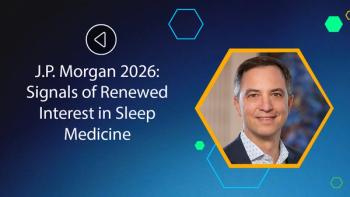
Fear of opioids
Why physicians are afraid to prescribe them and what you can do to set their minds at ease.
As anyone who has followed the opioid market during the past decade can attest, this marketplace has changed dramatically. Owing to several phenomena â namely, the advent of sustained-release opioids, newer technologies such as the transdermal patch, implantable pumps and other delivery systems, and a national focus on the management of pain â this market has exploded.
Opioids are now being prescribed routinely for chronic pain conditions that were heretofore treated with a variety of low-potency agents. It is not at all uncommon now for primary care physicians to prescribe sustained-release opioid products that were once used only by oncologists and pain specialists.
Lingering fear
Despite the ostensible empowerment of the masses to use these medications, a persistent trepidation has remained in the minds of many physicians who would otherwise be inclined to use opioids.
Simply stated, the objection that I heard 20 years ago and continue to hear today is that physicians fear that prescribing opioids will make them vulnerable to increased scrutiny by state and federal regulators, both of whom have the power to strip licenses and restrict practices. The natural consequence of this fear, whether the danger is real or imagined, is that physicians will sometimes under-treat legitimate pain for fear of regulatory reprisal.
A typical scenario is this: A physician prescribes an opioid in an amount and for a chronicity that varies from a self-developed "norm," whereupon a voice from within begins the process of active fretting, foreseeing a visit from jack-booted federal and state agents determined to audit the physician's prescribing practices and, in short order, visit untold wrath upon his or her license, practice and income. "And who needs that?" asks the voice from within.
While this hypothetical situation is exaggerated, the existence of the thought process is indisputable. In fact, the argument is routinely made that despite the rapid growth and acceptance of the use of opioids for malignant and non-malignant pain, fear of regulatory scrutiny still suppresses the adequate prescribing of opioids in this country.
In various publications, the American Pain Society, the Federation of State Medical Boards, the American Academy of Pain Management, the State Cancer Pain Initiatives and a host of other agencies have recognized this fear. In position statements, for example, many of these agencies cite a survey of California physicians published in the Aug. 15, 1994 issue of American Medical News, in which 69% of the respondents said that potential for disciplinary action "made doctors more conservative with opioids."
By most analyses, even the appearance of increased scrutiny can lead to a tempered enthusiasm for the prescribing of opioids. The most often-cited illustration of this phenomenon is data from New York State, where it was shown that in the year immediately following the advent of triplicate prescriptions - interpreted to mean "triplicate scrutiny" by some - the aggregate amount of opioid prescribing within the state decreased by 54%. Benzodiazapine prescriptions in New York also fell by 71% after the triplicates became law, according to the Journal of the American Medical Association (vol. 266, no. 2392â2397).
It would make for tidy closure if I could offer a simple rejoinder to overcome this objection; unfortunately, I do not believe one exists. That said, I do believe that there are means by which the objection can be diffused, thus making it less compelling in the minds of our customers.
Fear no more
When I address physician groups on this topic, it is my preference to maintain a Socratic (I ask, they answer), instead of a didactic (I talk, they listen), forum. For the purpose of discussion, I like to ask the physicians what they feel are the salient issues germane to this topic, and as a follow-up, I inquire if anyone knows of a colleague who has been entangled in one of these matters.
Interestingly, despite having given this presentation to numerous physician groups and individual providers, I have heard only one relevant anecdote. In addition, the extent of the described reprimand was a disciplinary letter from the state medical board, and it was issued because the physician failed to offer an opioid to a chronic-pain patient who needed one.
The point is that the incidence of these problems is questionable. That said, is it fair to say that no physicians have been punished for the intentional overuse of opioids? Of course not. But the events, when they do occur, survive as suburban legends with little basis. In fact, a look at the hard numbers illustrates that although the amount of opioids being prescribed is increasing sharply, the number of disciplinary actions taken against physicians on regulatory matters is actually declining.
Specifically, the Federation of State Medical Boards recently published data that depict the number of regulatory cases to have been flat or declining through the 1990s. On the other hand, there was a widely publicized Oregon case in late 1999, wherein a physician was sanctioned by the Oregon State Medical board for what was termed an egregious under-treatment of pain. To my knowledge, and in the eyes of most analysts, this was the first time such an action was taken against a physician for the under-treatment of pain, as opposed the over-prescribing of pain medications.
In the Oregon case, the physician had repeatedly refused to order morphine for dying cancer patients, and was subsequently rocked with sanctions and verbally berated by the State Medical Board. This physician was then enrolled in a one-year program in which another doctor worked with him to assess his practice and make improvements. In addition, the physician was also required to complete a course on physician/patient communication, and was ordered to meet with a psychiatrist, who in turn would issue reports to the Medical Board.
Does this suggest that the tide is turning? That the odds of receiving sanctions for the under-treatment of pain are now greater than the odds of being sanctioned for over-prescribing? Who knows?
What can be said is this: The American Bar Association has reported a sharp increase in the number of successful plaintiff actions for elderly claimants and their families, many of which have garnered substantial pain-and-suffering awards. A variety of juries have allowed plaintiff attorneys to pursue quality-of-life arguments for hospice and hospice-eligible patients when the end-of-life quality of care has been lacking.
This trend is notable inasmuch as these awards were virtually nonexistent just 15 years ago. An article in Newsweek described a plaintiff's attorney who won a single nursing home suit in Florida that served as the springboard for the development of a 300-attorney firm that deals with nothing but nursing home negligence.
I would argue that only in this legal atmosphere could we have judgments of $15 million for the inadequate treatment of pain, such as the case of Henry James v. Hillhaven Corp. In that case, a nurse withheld morphine from a prostrate cancer patient in direct defiance of a doctor's orders, and the patient subsequently died writhing in pain.
We have seen many subsequent actions on this issue, and we have reached the point where entire continuing legal education symposia are devoted to processing plaintiffs' claims for unnecessary pain and suffering caused by passive neglect. Where legal issues pertaining to pain management are concerned, prescribers would be wise to be more concerned about under-treatment, rather than over-treatment of pain with opioids.
The DEA
The point also needs to be made that throughout the layers of regulation promulgated and enforced by the Drug Enforcement Administration, there is neither mention nor controlling language that dictates the length of time that an opioid can or should be prescribed. Similarly, there is no mention of the amount of medication that can be given.
It is important to understand that the purpose of the DEA, under the auspices of the Controlled Substance Act, is to prevent the diversion of scheduled medications. This is done by enforcing: 1) a closed system of distribution by requiring written prescriptions for CII medications; 2) a DEA license to prescribe controlled substances; and 3) adequate record-keeping to document the patients' needs. These agents do not control the practice of medicine and, in short, do not present impediments to the judicious use of opioids for pain management.
The notion that DEA agents have the time and the inclination to perform random audits of prescribing habits is just not supported by reality. These agents, like most law enforcement personnel, respond to complaints when credible witnesses level them.
In the case of opioids, complaints usually come from collateral caregivers who bear witness to the willful disregard of the accepted practice of medicine. One local DEA agent is fond of telling a story in which patients were "tailgating" outside of a primary care office, each waiting a turn to be seen by the doctor, and then to receive an opioid. I'd call that a departure from the standard of care.
It would behoove us to understand that the "tailgate" example is the prototype case that triggers a regulatory inquiry, not the physician who is prescribing monthly opioids for a patient who has documented, intractable pain. Furthermore, a growing number of disciplinary and legal actions are occurring in those instances where opioid use is inadequate, as opposed to those cases where the prescribing has been over-zealous. The task is to arm yourself with the facts so that you are convinced; only then can you convince a physician of the same. PR
Newsletter
Lead with insight with the Pharmaceutical Executive newsletter, featuring strategic analysis, leadership trends, and market intelligence for biopharma decision-makers.




